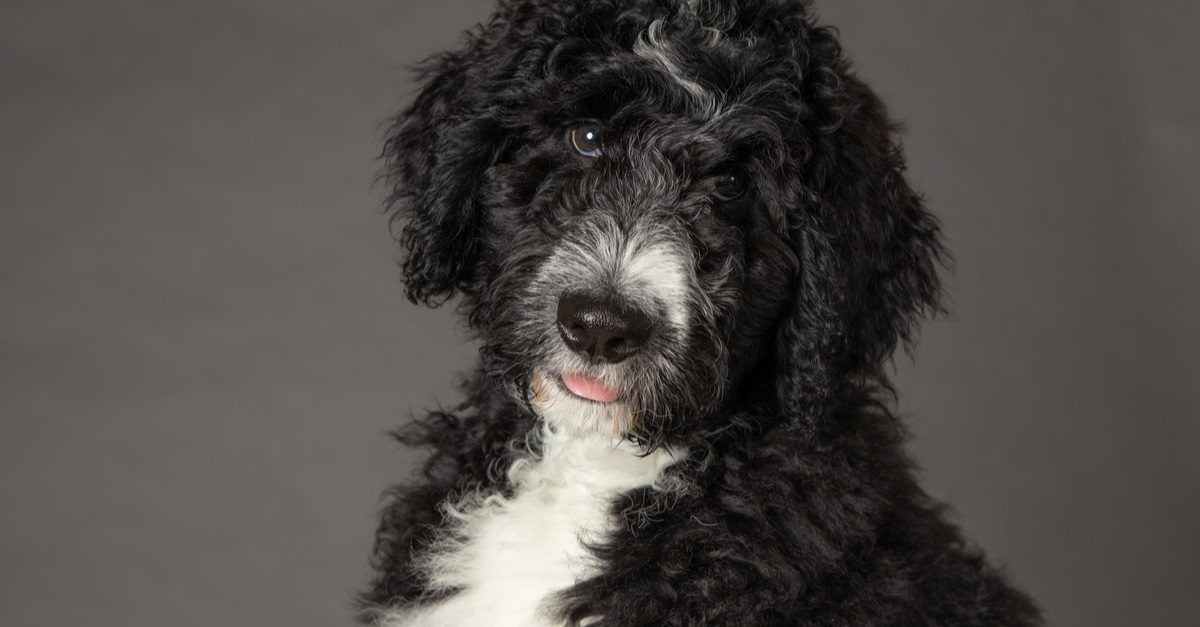Bernedoodle vs Aussiedoodle
Are you in search of the ideal family dog? Bernedoodles and Aussiedoodles are wonderful, family-friendly dogs with many similarities and differences to consider before adoption. These designer breeds are among the best companions for dog owners, much like the Golden Retriever, Bernese Mountain Dog, Cocktail Spaniel, German Shepherd, and Old English Sheepdog.
You’ll find that while both Aussiedoodles and Bernedoodles are loyal, friendly, intelligent, and make great companions, there are distinct differences between both dogs that you’ll want to get familiar with, so you can choose the best dog for your home.
Aussiedoodles
Aussiedoodles are an energetic, hard-working dog breed that crosses a Standard Poodle or Miniature Poodle with an Australian Shepherd. The Australian Shepherd was initially introduced to North America from Australia in the 1800s and quickly became a popular choice as working dogs as herders and guide dogs.
In the mid-1900s, Aussiedoodles were featured as a new hybrid breed and a family-friendly dog, which boosted their popularity as one of the top doodle dog breeds.
Bernedoodles
Bernedoodles are a pleasant, compatible mixed dog breed that combines a Bernese Mountain Dog and a Standard Poodle. They make great pets for families, with their calm, playful demeanor and great potential as therapy dogs.
Bernedoodles adapt well to different indoor and outdoor spaces and enjoy socializing with humans. The Bernese Mountain Dog originated from Switzerland and grew popular due to its playful, hard-working nature.
Physical Features of Aussiedoodles vs Bernedoodles
Aussiedoodles and Bernedoodles are similar in size, and both have a wavy coat or curly coat in various colors. Bernedoodles are slightly larger based on the poodle parent breed. In most cases, Bernedoodles are bred with standard poodles, which results in a weight range of between 60 and 90 pounds. They are also slightly taller than Aussiedoodles, with a maximum height of 29 inches.
Aussiedoodles are a bit smaller in size, on average, and are typically bred with a standard-size poodle mix, though you’ll find Mini Aussiedoodles that are bred with toy and miniature poodle breeds. Like Bernedoodles, this mixed-breed dog has a similar curly or wavy coat texture. They can weigh up to 70 pounds, with a maximum height of 24 inches.

Coat Texture and Color
Bernedoodles come in various colors and blends, including tri-color variations of white, black, gray, brown, dark red, and apricot. This dog breed is virtually non-shedding, making them ideal pets for anyone with allergies. The length of the fur varies from medium to lengthy and wavy to curly, depending on the poodle mix and parent breed.
Aussiedoodles have a similar fur texture and length to Bernedoodles, with various colors and blends, including chocolate, white, black, red merle, blue merle, and gray. Both breeds have floppy ears and have a similar body stature and size, depending on whether the poodle parent is a toy, mini, or standard poodle.
Grooming Requirements for Aussiedoodles vs Bernedoodles
Bernedoodles and Aussiedoodles require regular grooming to maintain their curly coat and prevent matting, tangles, and frizziness. Bernedoodles tend to have faster-growing hair, which may require more frequent visits to the professional groomer.
A great advantage to both doodle breed dogs is their low shedding. They both have hair-like coat-type fur, which requires regular brushing at least three times a week.
Behavior and Temperament
While both the Standard Aussiedoodle and Bernedoodle are active, loyal dogs, there are a few distinct differences to keep in mind. Aussiedoodles tend to be more energetic and love attention from humans.
As a puppy, they require a lot of outdoor play and enjoy an active lifestyle perfect for active people and children who can handle their rowdy behavior. While Aussiedoodles are natural herders and may nip on occasion, they are very loyal and eager to perform tasks for dog owners.
Bernedoodles are gentler than Aussiedoodles, though they enjoy friendly interaction and play. A Bernedoodle puppy loves to socialize, though their energy level is moderate compared to Aussiedoodles, and they tend to frighten easily, especially in unfamiliar spaces where there are unusual sounds or scents.
At the same time, they tend to be shy initially; Bernedoodles bond closely with their human companions.
Health and Life Expectancy
One of the benefits of mixed dog breeds is their excellent track record of health. They tend to have fewer health and medical conditions than purebreds, as the crossbreeding process reduces some hereditary illnesses and conditions, such as skin allergies, hip dysplasia, and cataracts.
Bernedoodles enjoy a slightly higher level of health, and a maximum life expectancy of up to 18 years, whereas Aussiedoodles can live up to 12 years.
Typically, both dog breeds are generally healthy and naturally active. Early detection of a medical condition or illness is the best way to provide treatment and regular visits to the veterinarian to improve your dog’s quality of life and well-being.
Training Aussiedoodles vs Bernedoodles
Both Aussiedoodles and Bernedoodles are receptive to training, despite being stubborn at times. They thrive on human interaction, and are eager to please, making them great loyal, family-oriented dogs. It’s essential to begin training early when they are puppies and regularly encourage socializing and play.
While both mixed breed dogs are easy to train, Bernedoodle puppies are a bit more stubborn, which can be a challenge initially. However, both breeds adapt easily and learn quickly with consistency and positive support.

Tips for Adopting an Aussiedoodles vs Bernedoodles
Whether you choose to adopt a Bernedoodle or Aussiedoodle, you’ll find both dogs make fantastic companions for dog owners of all ages, including families and children.
Whether you welcome a Miniature Bernedoodle or Standard Aussiedoodle into your family, it’s essential to prepare your home and take the following steps during this process:
- Adopt your puppy from a reputable breeder, and avoid puppy mills
- Get familiar with similar breeds, including the Mountain doodle, Australian Bernedoodle, Labrador Retriever, and various poodle breeds
- Inquire with your veterinarian and professional breeder about diet, exercise, and how to identify potential health issues
Summary
Bernedoodles and Aussiedoodles offer many wonderful personality traits, high intelligence, and energy that make them ideal family pets. While there are several distinct differences between these two mixed dog breeds, they adapt well to most homes and living spaces and enjoy playing outdoors.